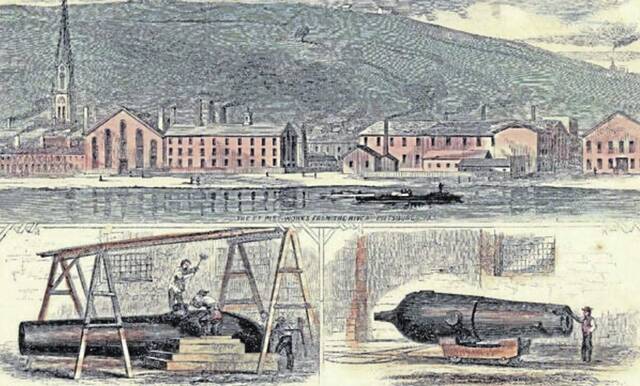One of the many videos the Oakmont Historical Society has produced over the years is devoted to the history of the Allegheny Valley Railroad in the Oakmont area.
In the video, the narrator mentions that during the Civil War, cannons were transported through Oakmont by train to be field-tested above New Kensington before being shipped off to war. There also is mention of the concussion of the cannon blasts echoing throughout the Alle-Kiski Valley during the tests.
The cannons mentioned in the video were manufactured at the Fort Pitt Foundry, which was founded in 1804. At the time of the Civil War, it was located in the Strip District across the street from the present site of the Senator John Heinz History Center.
The Fort Pitt Foundry was one of the foremost facilities for casting heavy ordnance in the United States. The foundry had invented a new technique for producing large cannons that were stronger and more durable than any seen up until that time.
Previously, cannons had been cast as a solid cylinder of steel. Once the casting had cooled, the bore was cut using lathes. With larger cannons, the outside of the casting cooled more quickly than the center of the casting, which caused stresses to build up within the metal. These stresses shortened the useful life of the cannon and resulted in cracking and failure.
The foundry developed a process in which a hollow cylinder of steel was cast so the steel closest to the center was able to be cooled more quickly. This resulted in a much stronger product — one that would not crack — and a life expectancy at least four times longer than conventionally produced cannons.
Cannons produced in this manner were called Rodman Guns after Thomas Rodman, the commander of the Allegheny Arsenal.
The Fort Pitt Foundry also produced the largest cannon in the world at that time. Called the Rodman Columbiad cannon, it was 20 feet long and weighed 58 tons. It was capable of shooting a 1,000-pound cannonball a distance of 4½ miles. Governments from around the world sent representatives to Pittsburgh to observe and learn the manufacturing techniques developed by the Fort Pitt Foundry for use by their militaries.
The Fort Pitt Foundry produced 80% of the Union Army’s heavy cannons and 15% of its field artillery during the Civil War. The foundry also produced more than 20,000 rounds of shot and shells of all calibers by the spring of 1862.
Upcoming Local Events
Because the foundry was in an urban setting, the cannons it produced had to be transported off-site for testing. A newspaper account from 1861 reported the cannons were transported by rail to a proving ground in Tarentum for field tests.
The only railroad operating along the Allegheny River at the time was the Allegheny Valley Railroad, which ran along the Lower Burrell side of the river. Neither New Kensington nor Braeburn Steel had been founded yet.
In 1856, the Allegheny Valley Railroad completed its tracks between Pittsburgh and Kittanning. The company opened a station that same year at the base of Craigdell Road and named it Tarentum Station.
The cannon produced by the Fort Pitt Foundry were extremely heavy, and there are numerous accounts of them being fired from the deck of a train car. This eliminated the dangerous work of transporting them off and on a train.
Because of their weight, it also was unlikely, if not impossible, to transport them by ferry across the river. It is believed that the testing area was on the Lower Burrell side of the river across from Tarentum near the base of Craigdell Road.
The railroad runs close to the face of a hill in the area between Chartiers Run and Craigdell Road, so firing cannons into the hillside at this point would have produced a landslide and threatened the railroad line.
Thus, it is likely they would use an area where the hillside set back from the tracks. The valley containing Craigdell Road is one such area, but the fact that it contained a usable roadway would eliminate it as a viable choice. It’s most likely that the valley slightly downstream from the Tarentum Bridge on the Lower Burrell side was the site for the testing area.
Shortly after the Civil War, the Fort Pitt Foundry shut down its operations, and in 1878, the land and equipment were sold to a competitor.



